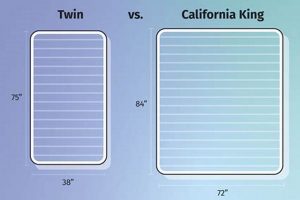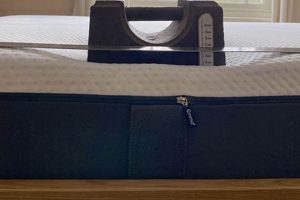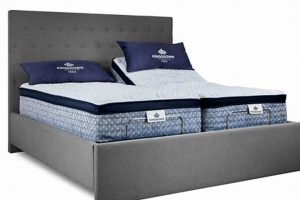The process of moving a large bed necessitates careful planning and execution. Due to its substantial dimensions, a king-sized sleeping surface presents unique logistical challenges, demanding specific strategies to ensure safe and efficient relocation. Proper techniques are crucial to prevent damage to the item, the surrounding environment, and potential injury to those involved.
Successfully managing this task offers numerous advantages, including cost savings by avoiding professional moving services, maintaining control over the handling of a valuable possession, and adhering to a self-imposed relocation timeline. Furthermore, understanding optimal procedures contributes to the preservation of the mattress’s structural integrity and hygiene, extending its lifespan and comfort. Historically, this activity was often undertaken without specialized equipment, relying solely on manual labor; however, modern tools and methods have greatly improved both safety and efficiency.
This article will outline key steps to consider, including preparation, appropriate materials, safe lifting techniques, securing the item during transit, and potential obstacles to anticipate during a bed relocation operation. Careful consideration of these topics ensures a smoother and less stressful experience.
Guidance for Relocating a King Size Bed
The following recommendations serve as a guide to facilitate the transfer of a large mattress. Adhering to these guidelines will minimize potential risks and ensure a smoother operation.
Tip 1: Secure Necessary Supplies: Gather items such as a heavy-duty mattress bag or plastic sheeting, packing tape, furniture straps, and moving blankets. These materials provide protection from dirt, damage, and shifting during transport.
Tip 2: Enlist Assistance: Due to its size and weight, this object typically requires at least two individuals to maneuver safely. Securing assistance prevents potential injuries and simplifies the lifting process.
Tip 3: Prepare the Environment: Clear pathways within the home, removing obstacles such as furniture or loose items. This minimizes the risk of tripping or damaging surrounding structures.
Tip 4: Utilize Proper Lifting Techniques: Bend at the knees, maintain a straight back, and lift with the legs. This prevents strain on the back and reduces the likelihood of injury.
Tip 5: Completely Enclose the Mattress: Slide the item into a mattress bag or wrap it thoroughly with plastic sheeting, sealing all openings with packing tape. This protects the mattress from dirt, moisture, and potential infestations.
Tip 6: Secure to Vehicle: When transporting within a vehicle, utilize furniture straps to firmly secure the mattress to the interior walls or floor. This prevents movement during transit, which can cause damage or pose a safety hazard.
Tip 7: Consider Vehicle Dimensions: Ensure that the selected vehicle is of adequate size to accommodate the dimensions of the mattress. Attempting to transport it in an undersized vehicle can lead to damage and safety risks.
These suggestions offer practical methods to improve the process and ensure that the transport goes well. Consideration of each point will create a much better experience.
Ultimately, proper planning and execution are paramount for a successful outcome. Proceeding with caution and attention to detail minimizes potential challenges and facilitates a smoother transition.
1. Preparation
Effective preparatory actions are paramount when relocating a king-size mattress. The degree of preparation directly influences the efficiency, safety, and ultimate success of the endeavor. Insufficient planning often results in preventable damage to the mattress, the surroundings, or potential physical strain on the individuals involved. For instance, failing to measure doorways or stairwells prior to the move may lead to unforeseen obstacles and necessitate awkward maneuvers, increasing the risk of damage. Conversely, a meticulously planned approach, including securing appropriate packing materials and enlisting sufficient manpower, mitigates potential complications and streamlines the process. The cause-and-effect relationship between preparation and a successful move is undeniable; inadequate planning invariably results in heightened stress and increased potential for mishaps.
The practical significance of comprehensive preparation extends beyond mere convenience. Properly encasing the mattress in a protective cover prevents contamination from dirt, dust, and potential pests during transport. Securing furniture straps in advance allows for efficient and safe immobilization within the moving vehicle. Organizing and pre-packaging other items to be moved simultaneously minimizes clutter and facilitates a more organized loading process. A real-life example might involve a homeowner who neglected to purchase a mattress bag. Consequently, the mattress became soiled and required professional cleaning after the move, incurring additional expense and inconvenience. Such scenarios underscore the direct correlation between preparedness and a positive outcome.
In summary, preparation serves as the bedrock upon which a successful mattress relocation is built. It encompasses proactive planning, securing necessary materials, and anticipating potential challenges. By prioritizing thorough preparation, individuals can significantly reduce the likelihood of damage, injury, and unnecessary stress, thereby ensuring a smoother and more efficient overall moving experience. The inherent challenges associated with handling such a large item are effectively mitigated through diligent preparation, reinforcing its crucial role in the overall process.
2. Protection
The safeguarding of a king-size mattress during relocation is not merely a precautionary measure, but a critical component dictating the mattress’s condition upon arrival. The inherent dimensions and porous nature of bedding render it particularly vulnerable to environmental contaminants and physical damage. Without adequate protection, exposure to dirt, moisture, and abrasive surfaces during transit can lead to irreversible staining, structural compromise, and the potential introduction of allergens or pests. The cause-and-effect relationship is direct: inadequate protection invariably leads to a compromised mattress, necessitating costly cleaning, repair, or even premature replacement. Proper protection serves as a preventative measure, mitigating these risks and preserving the integrity of the investment.
The practical application of protection manifests primarily through the use of specialized mattress bags or durable plastic sheeting. These barriers create a physical shield against external elements, preventing direct contact with potentially damaging substances. Furthermore, padding materials, such as moving blank
ets, can be strategically employed to cushion the mattress against impacts and abrasions during handling and transport. Consider the scenario where a mattress is moved without a protective covering; exposure to rain during transit could result in water damage, fostering mold growth and rendering the mattress unsanitary and unusable. Conversely, a mattress properly encased in a waterproof bag would remain dry and protected, preserving its condition and preventing potential health hazards. Another example would be dragging the uncovered mattress causing tear on the surface and inner cotton damages.
In summary, protection is inextricably linked to the successful transport of a king-size mattress. It is not an optional add-on but a fundamental requirement for preserving the item’s value, hygiene, and structural integrity. While challenges may arise in selecting appropriate protective materials or securing them effectively, the long-term benefits of diligent protection far outweigh the initial investment of time and resources. Neglecting this crucial aspect of the relocation process inevitably leads to increased risk and potential financial burden, underscoring the paramount importance of prioritizing protection during every stage of the transport process.
3. Lifting Technique
Proper lifting technique is not merely a suggestion but a critical imperative when dealing with the task of transporting a king-size mattress. The significant weight and bulk of the item present substantial risks of musculoskeletal injury if handled improperly. Therefore, understanding and implementing correct lifting procedures directly influences the safety and success of the entire operation.
- Maintaining Spinal Alignment
A neutral spine, achieved by keeping the back straight and engaging core muscles, is fundamental to safe lifting. Bending at the knees and hips, rather than the waist, minimizes stress on the lumbar region. An individual attempting to lift a heavy object with a rounded back concentrates force on the spinal discs, potentially leading to herniation or strain. Maintaining proper spinal alignment distributes the load more evenly, reducing the risk of injury. During the mattress transport, this translates to consistent awareness of posture and avoidance of twisting motions while lifting or carrying.
- Engaging Leg Muscles
The legs possess significantly greater strength and endurance compared to the back. Utilizing leg muscles to power the lift, rather than relying on the back, is essential. This involves squatting down to grasp the mattress, maintaining a straight back, and then straightening the legs to raise the load. A failure to engage leg muscles places undue stress on the back, increasing the risk of muscle strain or disc injury. When shifting a mattress, leg strength enables controlled movements and minimizes the potential for sudden, jarring motions that could cause injury.
- Coordinated Teamwork
Transporting a king-size mattress generally requires at least two individuals. Effective teamwork, characterized by clear communication and synchronized movements, is crucial for distributing the load evenly and preventing imbalances that could lead to injury. Before lifting, the team should agree on a plan of action, including lifting points and communication signals. An example of poor teamwork is when one person lifts before the other is ready, resulting in uneven weight distribution and increased strain on both individuals. Synchronized lifting and carrying ensures a smoother, safer process.
- Avoiding Twisting and Jerking
Twisting the torso while lifting or carrying a heavy object places extreme stress on the spine and supporting muscles. Similarly, sudden, jerky movements can overload the musculoskeletal system and increase the risk of injury. Maintaining a stable posture and using small, controlled steps when moving the mattress minimizes the potential for these harmful movements. This necessitates careful planning of the route and removal of obstacles that could force sudden changes in direction or speed. A slow, deliberate approach prioritizes safety and reduces the likelihood of injury.
In summary, adopting proper lifting techniques transforms the inherently risky task of transporting a king-size mattress into a significantly safer undertaking. By prioritizing spinal alignment, engaging leg muscles, fostering coordinated teamwork, and avoiding twisting or jerking motions, individuals can minimize the potential for injury and ensure a successful mattress relocation. These techniques are not merely recommendations; they are essential elements of responsible and effective moving practices.
4. Vehicle Suitability
The selection of an appropriate vehicle is a critical determinant in the successful and safe transport of a king-size mattress. This aspect of logistical planning directly impacts the feasibility of the operation, influencing factors such as the risk of damage to the mattress, the safety of those involved, and adherence to traffic regulations. The vehicle’s capacity and configuration must align with the dimensions and weight of the item to be transported.
- Internal Dimensions and Capacity
The internal dimensions of the vehicle must be sufficient to accommodate the king-size mattress without excessive compression or bending. Attempting to force the mattress into an undersized space can result in structural damage, compromising its integrity. Furthermore, the vehicle’s weight capacity must not be exceeded, as overloading can negatively affect handling, braking performance, and overall safety. An example would be trying to fit a standard king mattress (76 inches wide and 80 inches long) in a compact car.
- Vehicle Type and Configuration
Certain vehicle types are inherently better suited for mattress transport than others. Open-bed trucks or vans with ample cargo space provide the most flexibility and ease of loading. In contrast, passenger cars with limited trunk space present significant challenges and may necessitate unsafe or illegal transport methods, such as securing the mattress to the roof without proper restraints. Another configuration would be using a trailer hitch attachment that would allow the vehicle to be properly configured for secureness.
- Weather Protection Considerations
The chosen vehicle should provide adequate protection from the elements, particularly in inclement weather. Exposure to rain, snow, or excessive sunlight can damage the mattress, leading to staining, mold growth, or degradation of materials. Enclosed vehicles, such as vans or covered trucks, offer the best protection. If an open-bed truck is used, securing a waterproof tarp over the mattress is essential to prevent weather-related damage.
- Securing Points and Restraints
The vehicle must possess adequate securing points and restraints to ensure the mattress remains stable during transit. These may include cargo tie-down points, D-rings, or integrated strapping systems. Proper securing prevents the mattress from shifting, sliding, or falling out of the vehicle, reducing the risk of accidents and damage. Failure to adequately secure the mattress can result in hazardous situations, particularly during sudden stops or turns.
In conclusion, careful assessment of vehicle suitability is param
ount when planning for mattress relocation. By considering the vehicle’s dimensions, configuration, weather protection capabilities, and securing points, individuals can significantly reduce the risks associated with transport and ensure the mattress arrives at its destination in optimal condition. The selection of an appropriate vehicle is not merely a matter of convenience but a critical factor in the overall success and safety of the entire operation.
5. Securing Method
The methods employed to secure a king-size mattress during relocation are pivotal to preventing damage and ensuring transport safety. The size and weight of these items necessitate strategies that go beyond simply placing the mattress in a vehicle. Effective securing techniques mitigate risks associated with shifting cargo, sudden stops, and unforeseen road conditions. Neglecting appropriate securing methods can lead to damage to the mattress itself, the transporting vehicle, and potentially cause accidents resulting in injury.
- Strapping and Tie-Down Techniques
Straps, ropes, or specialized tie-downs are essential for immobilizing the mattress within the vehicle. These restraints should be strategically positioned to prevent horizontal and vertical movement. For instance, furniture straps looped through anchor points in a truck bed and tightened securely around the mattress can effectively prevent it from sliding or tipping during transit. Inadequate strapping could result in the mattress shifting during a turn, potentially damaging it or even causing it to fall from the vehicle.
- Vehicle Placement and Orientation
The manner in which the mattress is placed within the vehicle significantly impacts the effectiveness of securing efforts. Placing the mattress flat, rather than on its side, often provides a more stable base for securing. Additionally, positioning the mattress against a solid surface, such as the headboard of a truck bed, can further restrict movement. Improper placement, such as positioning the mattress diagonally across the vehicle bed, creates instability and increases the likelihood of shifting during transport.
- Padding and Protection at Contact Points
Direct contact between the mattress and the vehicle’s interior can lead to abrasions and damage, particularly during longer journeys. Padding materials, such as moving blankets or foam, should be placed at all contact points to cushion the mattress and prevent rubbing against hard surfaces. Neglecting this precaution could result in unsightly scuffs or tears to the mattress fabric. For example, corners and edges are especially prone to damage if not properly padded.
- Regular Inspection During Transit
Even with meticulous initial securing, it is advisable to periodically inspect the restraints during longer trips. Vibrations and road conditions can cause straps to loosen or shift, compromising the security of the load. Regular inspection allows for timely adjustments and prevents potential problems from escalating. For instance, a driver might stop after the first hour of driving to check that the straps are still taut and the mattress remains securely positioned.
The interplay between these securing facets directly influences the success of the transport operation. Inadequate securing can result in a damaged mattress, posing financial burdens and logistical challenges. Therefore, a comprehensive and proactive approach to securing methods is essential for ensuring the safe and damage-free relocation of a king-size mattress. Effective techniques are not merely optional; they represent a fundamental element of responsible moving practices.
Frequently Asked Questions
The following addresses common inquiries concerning the relocation of large bedding. This section provides definitive answers to crucial aspects of the process, ensuring a clearer understanding of the challenges and optimal solutions involved.
Question 1: Is professional assistance always necessary for moving a king-size mattress?
Professional assistance is not invariably required, but is strongly recommended, especially when encountering logistical difficulties such as narrow stairwells or long distances. The decision hinges on factors like available manpower, physical capability, and access to appropriate equipment. Individuals lacking experience with heavy lifting should consider professional services to mitigate potential risks.
Question 2: What are the potential consequences of transporting a mattress unprotected?
Transporting a mattress without proper protection exposes it to various environmental contaminants, including dirt, moisture, and potential pests. This can lead to irreversible staining, structural damage, and the introduction of allergens. Moreover, unprotected mattresses are more susceptible to tears and abrasions during handling and transit.
Question 3: How crucial is proper lifting technique in preventing injuries during mattress relocation?
Proper lifting technique is of paramount importance. Incorrect lifting practices can result in severe back strain, muscle sprains, and potential spinal injuries. Utilizing proper form, engaging leg muscles, and coordinating with lifting partners are essential for minimizing the risk of injury.
Question 4: What type of vehicle is best suited for transporting a king-size mattress?
Vehicles with ample cargo space and a flat loading surface are preferable. Open-bed trucks, cargo vans, or trailers are typically the most suitable options. Passenger vehicles with limited trunk space are generally inadequate and may necessitate unsafe or illegal transport methods.
Question 5: Is it permissible to transport a mattress on the roof of a car?
Transporting a mattress on the roof of a car is generally discouraged and may be illegal in certain jurisdictions. This practice poses significant safety risks, including the potential for the mattress to detach during transit, causing accidents. Furthermore, securing a mattress to a car roof often lacks the stability and restraint necessary to prevent damage.
Question 6: What steps should be taken if damage occurs to the mattress during transport?
In the event of damage, a thorough assessment of the extent of the damage is necessary. Depending on the severity, options include professional cleaning, repair, or replacement. If a moving company was involved, documenting the damage with photographs and filing a claim with the company is advisable.
In summary, careful planning and execution are critical for successful king-size mattress transport. Adhering to safety guidelines, utilizing appropriate equipment, and considering environmental factors are key to preventing damage and ensuring a smooth relocation process.
The succeeding section explores alternative strategies and innovative approaches to optimize mattress handling, offering adaptable solutions for unique logistical challenges.
Concluding Considerations for King Size Mattress Transport
This article explored key aspects of bed relocation, underscoring the significance of preparation, protection, proper lifting techniques, vehicle suitability, and securement methods. The effective implementation of these strategies minimizes the risk of damage to the mattress and injury to personnel. Addressing each area directly contributes to a more streamlined and efficient process.
Prioritizing these established methods ensures a more se
cure and less arduous undertaking. With thorough planning and diligent execution, the complexities associated with king-size mattress relocation can be effectively managed. Continued adherence to safety protocols and best practices remains paramount for successful outcomes. Future innovations in moving technology may further enhance the process, but fundamental principles of careful handling and secure transport will endure.




![Best King Medium Mattress [Guide] - Sleep Like a King! Organic & Natural Mattress Buyer’s Guide: Non-Toxic Sleep Solutions Best King Medium Mattress [Guide] - Sleep Like a King! | Organic & Natural Mattress Buyer’s Guide: Non-Toxic Sleep Solutions](https://mattressworldpa.com/wp-content/uploads/2025/07/th-8153-300x200.jpg)


